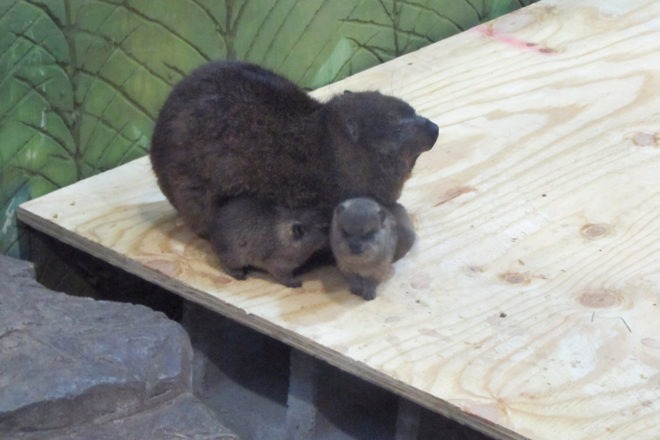The Maryland Zoo in Baltimore is welcoming its newest arrivals — two rock hyrax babies, born to Roscoe and Palele, the Zoo’s adult hyrax.
The babies were born early Sunday morning, July 12. “So far the babies are active and energetic and appear to be in good health,” commented Mike McClure, the Zoo’s general curator. “Mother hyraxes prefer to nurse in cool, dark places, so it is difficult to tell if they are nursing from Mom as of yet, but we are optimistic given their energy level.” As they appear to be thriving, it will be some time before staff gives them their first veterinary exam.
Rock hyraxes (Procavia capensis) look like very large guinea pigs but actually are most closely related to elephants. Their front teeth, which resemble those of a rodent, are thought to be remnants of tusks. They are native to Africa and the Middle East and they prefer rocky or shrub-covered areas bordering dry savannahs.
Female rock hyraxes give birth to two or three offspring at a time and are fierce defenders of their young. Because of this, the colobus monkeys, red tail guenons, and African porcupines that usually share space with the hyrax may not always be on exhibit while the hyrax babies are growing. The babies are well developed at birth and can be running around within an hour. Rock hyraxes are well adapted to their rocky terrain and their position on the food chain. Their feet are naturally sticky and they function like little suction cups to provide a secure grip on uneven terrain, and their oversized mouths allow them to eat quickly, which is important because they are most vulnerable to attack when feeding.
Although technically most closely related to elephants, their evolutionary paths diverged many millions of years ago. Even so, hyraxes still share numerous features with elephants, including toenails, acute hearing, sensitive foot pads, and tusks (small in hyraxes, big in elephants). Hyraxes also are thought to share remote common ancestry with marine-dwelling sea cows (dugongs and manatees). Hyrax are very common in their range, much like squirrels are in Maryland.






Share this article